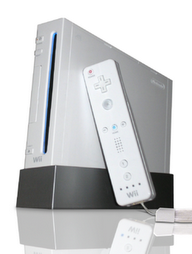Technical specifications
Technical specifications
Nintendo has released few technical details regarding the Wii system, but some key facts have leaked from the press. Though none of these reports has been officially confirmed, they generally point to the console as being an extension or advancement of the Nintendo GameCube architecture. More specifically, the reported analyses state that the Wii is roughly 1.5 to two times as powerful as its predecessor.[
Processors:
CPU: PowerPC based "Broadway" processor, made with a 90 nm SOI CMOS process, reportedly† clocked at 729 MHz[44] GPU: ATI "Hollywood" GPU made with a 90 nm CMOS process,[45] reportedly† clocked at 243 MHz
Memory:
88 MiB main memory (24 MiB "internal" 1T-SRAM integrated into graphics package, 64 MiB "external" GDDR3 SDRAM) 3 MiB embedded GPU texture memory and framebuffer.
Storage:
512 MiB built-in NAND flash memory Expanded storage via SD card memory (up to 2 GB) Nintendo GameCube Memory Card (required for GameCube game saves) Slot-loading disc drive compatible with 8 cm Nintendo GameCube Game Disc and 12 cm Wii Optical Disc Mask ROM by Macronix
Ports and peripheral capabilities:
Up to four Wii Remote controllers (connected wirelessly via Bluetooth) Nintendo GameCube controller ports (4) (one can be used in conjunction with four Wii Remote units for five-player multiplayer capability) Nintendo GameCube Memory Card ports (2) SD memory card slot USB 2.0 ports (2) Sensor Bar port Accessory port on bottom of Wii Remote Mitsumi DWM-W004 WiFi 802.11b/g wireless module Compatible with optional USB 2.0 to Ethernet LAN adaptor Multi-output port for component, composite or S-Video
Video:
480p (PAL/NTSC), 480i (NTSC) or 576i (PAL/SECAM), standard 4:3 and 16:9 anamorphic widescreen[49] Component (including Progressive scan), RGB SCART (PAL only), S-Video (NTSC only), composite output, or D-Terminal Audio:
Main: Stereo – Dolby Pro Logic II-capable[51] Controller: Built-in speaker
Built-in content ratings systems:
BBFC, CERO, ESRB, OFLC, OFLC (NZ), PEGI, USK
Technical issues
The first firmware update via WiiConnect24 caused a very small portion of units to become completely unusable. This forced users to either send their units to Nintendo for repairs (if they wished to retain their saved data), or exchange it for a free replacement. It has also been reported that during standby mode, the Wii can overheat to the point of damaging the GPU, causing pixelation problems, such as random dark or green pixels, to appear. As of April 21, 2007, it is possible to contact Nintendo and send it for repair. A small number of routers are partially or totally incompatible with the Wii console, due to the way the Wii interacts with them, and the firewalls that the routers use. Although the firewall in some routers can be disabled to provide partial or full functionality with the Wii, some firewall settings on some routers cannot be changed and therefore are incompatible with the Wii. Nintendo has provided a list of incompatible units.
Legal issues
Interlink Electronics filed a patent-infringement lawsuit against Nintendo over the pointing functionalities of the Wii Remote, claiming, "loss of reasonable royalties, reduced sales and/or lost profits as a result of the infringing activities" of Nintendo.[55] Anascape Ltd, a Texas-based firm, also filed a lawsuit against Nintendo for patent infringements.[56] Green Welling LLP filed a class action lawsuit against Nintendo for their "defective wrist straps."[57] A Texas-based company called Lonestar Inventions has also sued Nintendo, claiming that the company copied one of Lonestar's patented capacitor designs and used it in the Wii console.[58]


No comments:
Post a Comment